 HITLERS WAR MACHINE TIGER I Official Wartime Crew Manual (The Tigerfibel) Translated and edited by Bob Carruthers
HITLERS WAR MACHINE TIGER I Official Wartime Crew Manual (The Tigerfibel) Translated and edited by Bob Carruthers  www.codahistory.com This ebook edition published in Great Britain in 2011 by Coda Books Ltd, Unit 1, Cutlers Farm Business Centre, Edstone, Wootton Wawen, Henley in Arden, Warwickshire, B95 6DJ www.codahistory.com Copyright 2011 Coda Books Ltd All rights reserved. No part of this publication may be reproduced or transmitted in any form or by any means, electronic or mechanical, including photocopy, recording, or any information storage and retrieval system, without permission in writing from the publisher. A CIP catalogue record for this book is available from the British Library ISBN 978 1 908538 06 2 INTRODUCTION & TRANSLATION NOTES The Tiger I was the most famous heavy tank produced in World War II. It was developed in great haste during 1942 by the Henschel & Sohn company in order to combat the Russian T-34 and the KV-1 . The Tiger was envisaged as being as the answer to the unexpectedly formidable Soviet armor encountered in the initial months of Operation Barbarossa, during 1941. This radical new breed of tank was designed to house a new type of Kampfwagenkanone (or tank gun) based on the German high velocity 88mm Flugzeugabwehr-Kanone, the famous Flak 36 anti-aircraft gun which had been forced into action in an anti-tank role in Russia and the western desert.
www.codahistory.com This ebook edition published in Great Britain in 2011 by Coda Books Ltd, Unit 1, Cutlers Farm Business Centre, Edstone, Wootton Wawen, Henley in Arden, Warwickshire, B95 6DJ www.codahistory.com Copyright 2011 Coda Books Ltd All rights reserved. No part of this publication may be reproduced or transmitted in any form or by any means, electronic or mechanical, including photocopy, recording, or any information storage and retrieval system, without permission in writing from the publisher. A CIP catalogue record for this book is available from the British Library ISBN 978 1 908538 06 2 INTRODUCTION & TRANSLATION NOTES The Tiger I was the most famous heavy tank produced in World War II. It was developed in great haste during 1942 by the Henschel & Sohn company in order to combat the Russian T-34 and the KV-1 . The Tiger was envisaged as being as the answer to the unexpectedly formidable Soviet armor encountered in the initial months of Operation Barbarossa, during 1941. This radical new breed of tank was designed to house a new type of Kampfwagenkanone (or tank gun) based on the German high velocity 88mm Flugzeugabwehr-Kanone, the famous Flak 36 anti-aircraft gun which had been forced into action in an anti-tank role in Russia and the western desert.
This was the only German gun on the battlefield which had demonstrated its effectiveness against heavily armored ground targets such as the KV1 and which was portable enough to be adapted in order to fit into a tank. It was rapidly redesigned for conversion into the Kwk 36 / L56 which was a parallel development designed to produce a gun which could be mounted into the 11 ton turret of the Tiger I. Rushed into service in August 1942, the Tiger I design had many flaws and design faults. It was essentially still at prototype stage, but at least it gave the Panzerwaffe its first tank capable of mounting the fearsome 88 mm gun as its main armament. The Roman numeral I was only officially added in 1944 when the later Tiger II entered production. The initial official German designation was Panzerkampfwagen VI Ausfhrung H (Panzer VI version H, abbreviated to PzKpfw VI Ausf.
H ), but somewhat confusingly the tank was redesignated as PzKpfw VI Tiger Ausf. E in March 1943. It also had the ordnance inventory designation SdKfz 181 . The Tiger was first saw action on 22nd September 1942 near Leningrad. It was not an instant success. Under pressure from Hitler, the tank was driven into action in unfavourable terrain months earlier than planned.
The early models, not surprisingly, proved to be mechanically unreliable; in this first action there were breakdowns. More worryingly three others were easily knocked out by dug-in Soviet anti-tank guns aiming at the running gear, although there was some comfort in the fact that none suffered a hit that actually managed to pierce the armor of the tank. Just as there was a great need of haste in producing the Tiger I, so too was there a need to train effective crews. The very best of the existing tank crews were soon creamed off to form the cadre of the Tiger tank crews - the elite of the Panzerwaffe . A prospective Tiger crew member went through, as rapidly as possible, long hours of essential classroom study. This was coupled with extensive and hands-on training at the Panzer school located in Paderborn.
The head of training for the Inspectorate of the Panzerwaffe and also based at Paderborn was Oberstleutnant Hans Christern, an experienced tank commander who could provide proof to his own practical experience by dint of his possession of the Knight's Cross awarded to him for bravery in the field. With the introduction of the Tiger I (Ausf H) in late 1942, Christern found himself faced with the need to rapidly instruct crews in the operation of a very different type of vehicle. For the first time Germany possessed a heavy tank worthy of the name. Tactically this tank had to be handled very differently; in manner and mechanically it needed far more care and attention than any other machine so far delivered to the Panzewaffe. Everything needed to be done in a hurry. Christern therefore decided it would help to move matters along if he were to replace the usual dusty tank instruction manual with a special training booklet for the Tiger students which was simple yet memorable.
The end result was certainly a success on both counts. The simplistic but effective style recalled a childrens school book. It was therefore given the name Tigerfibel , which means Tiger primer. This booklet was assigned the official publication number of D656/27. The task of actually writing the new training manual was assigned to Leutnant Josef von Glatter-Goetz. Glatter-Goetz took the assignment to heart and gave serious consideration to the need to impart such a large amount of information quickly and make it stick in the minds of bored young tank men.
He therefore developed the idea of writing a humorous and highly risqu manual that would hold fast in the memories of the young men training on the Tiger. To do this he used humorous and risqu cartoon illustrations along with slang and the everyday situations which it was hoped the target audience would identify with.  Hans Christern The illustrations in the Tigerfibel were completed by two serving soldiers named Obergrenadier Gessinger and Unteroffizier Wagner. This wide range of images included the usual technical drawings and photographs, supplemented by a range of cartoons. Wherever possible the cartoons featured an attractive and curvaceous blonde named Elvira. She was depicted naked as often as possible and somewhat predictably was the romantic target for the affections of a Tiger crewman who gets the girl in the end.
Hans Christern The illustrations in the Tigerfibel were completed by two serving soldiers named Obergrenadier Gessinger and Unteroffizier Wagner. This wide range of images included the usual technical drawings and photographs, supplemented by a range of cartoons. Wherever possible the cartoons featured an attractive and curvaceous blonde named Elvira. She was depicted naked as often as possible and somewhat predictably was the romantic target for the affections of a Tiger crewman who gets the girl in the end.
The Tigerfibel also contains some short verses and rhyming couplets which do not lend themselves readily to an exact translation from German and English, but have been rendered as closely as possible to the produce essence of what was intended. Each of the five fictitious crew-members appearing in the Tigerfibel was given a memorable name connected with his function. The commander was Speedy the right timer which might better be rendered in English as Speedy Quickthinker. His driver was Gustav the land rover, the radio operator was Funker Piepmatz the decrypter, the gun loader was Hulsensacke der Hemmungslose which is probably best translated as the the indefatigable and Gunner Holzauge the infallible was the man responsible for the effective use of the main weapon system. The manual covered a wide range of subjects and besides the obvious information concerning the Tiger I and its basic maintenance requirements and peculiarities, there was also important advice on gunnery and ammunition drill as well as a comprehensive run down on the type of enemy targets likely to be encountered. There was also advice on driving techniques, fuel conservation, how to deal with enemy infantry at close quarters and target spotting.
Although it was quite unconventional when compared to any other manual hitherto produced, the Tigerfibel was actually authorized by Guderian himself and it proved to be very effective training aid. Each Tigerfibel also came with a set of fold out supplements that were contained in a pocket on the inside of the back cover. One of these supplements was an enemy vehicle recognition chart, which folded out to reveal good black and white photos and diagrammatic representations of the various Allied tanks which the Tiger I crew could be expected to encounter in the field. Another particularly interesting supplement was the graphic demonstration of the range the Tiger could be penetrated by or itself penetrate enemy tanks such as the Sherman M4, T-34 or KV1. In addition to the advice on fighting and maintaining the machine, the Tigerfibel also affords a fascinating insight into the deteriorating supply situation in the form of exhortations to conserve ammunition and to overrun targets rather than use precious shells. The Tigerfibel is also noteworthy for the fact that no Nazi iconography appears anywhere in the booklet.
Next page
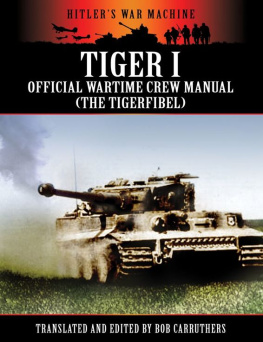
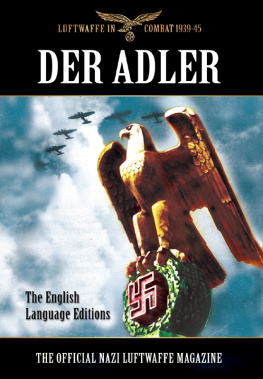


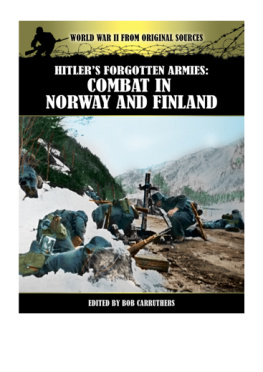

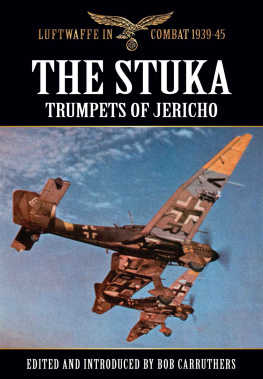

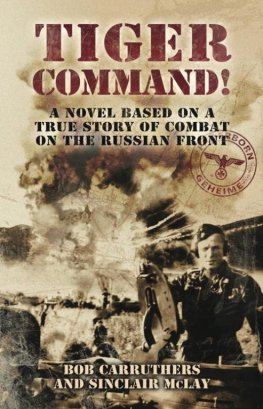


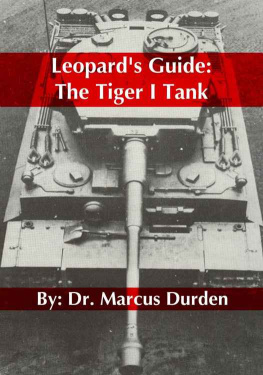
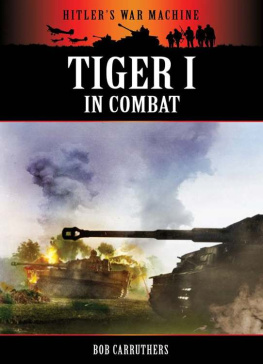
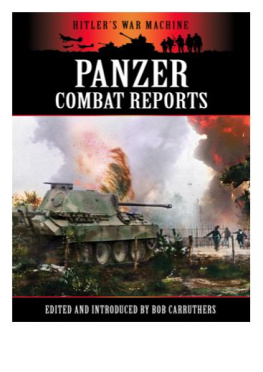
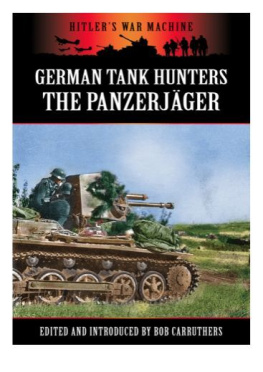
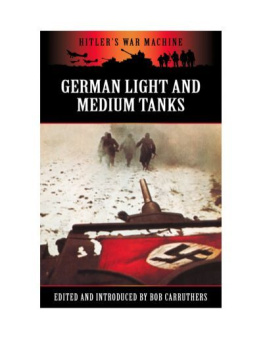

 HITLERS WAR MACHINE TIGER I Official Wartime Crew Manual (The Tigerfibel) Translated and edited by Bob Carruthers
HITLERS WAR MACHINE TIGER I Official Wartime Crew Manual (The Tigerfibel) Translated and edited by Bob Carruthers  www.codahistory.com This ebook edition published in Great Britain in 2011 by Coda Books Ltd, Unit 1, Cutlers Farm Business Centre, Edstone, Wootton Wawen, Henley in Arden, Warwickshire, B95 6DJ www.codahistory.com Copyright 2011 Coda Books Ltd All rights reserved. No part of this publication may be reproduced or transmitted in any form or by any means, electronic or mechanical, including photocopy, recording, or any information storage and retrieval system, without permission in writing from the publisher. A CIP catalogue record for this book is available from the British Library ISBN 978 1 908538 06 2 INTRODUCTION & TRANSLATION NOTES The Tiger I was the most famous heavy tank produced in World War II. It was developed in great haste during 1942 by the Henschel & Sohn company in order to combat the Russian T-34 and the KV-1 . The Tiger was envisaged as being as the answer to the unexpectedly formidable Soviet armor encountered in the initial months of Operation Barbarossa, during 1941. This radical new breed of tank was designed to house a new type of Kampfwagenkanone (or tank gun) based on the German high velocity 88mm Flugzeugabwehr-Kanone, the famous Flak 36 anti-aircraft gun which had been forced into action in an anti-tank role in Russia and the western desert.
www.codahistory.com This ebook edition published in Great Britain in 2011 by Coda Books Ltd, Unit 1, Cutlers Farm Business Centre, Edstone, Wootton Wawen, Henley in Arden, Warwickshire, B95 6DJ www.codahistory.com Copyright 2011 Coda Books Ltd All rights reserved. No part of this publication may be reproduced or transmitted in any form or by any means, electronic or mechanical, including photocopy, recording, or any information storage and retrieval system, without permission in writing from the publisher. A CIP catalogue record for this book is available from the British Library ISBN 978 1 908538 06 2 INTRODUCTION & TRANSLATION NOTES The Tiger I was the most famous heavy tank produced in World War II. It was developed in great haste during 1942 by the Henschel & Sohn company in order to combat the Russian T-34 and the KV-1 . The Tiger was envisaged as being as the answer to the unexpectedly formidable Soviet armor encountered in the initial months of Operation Barbarossa, during 1941. This radical new breed of tank was designed to house a new type of Kampfwagenkanone (or tank gun) based on the German high velocity 88mm Flugzeugabwehr-Kanone, the famous Flak 36 anti-aircraft gun which had been forced into action in an anti-tank role in Russia and the western desert. Hans Christern The illustrations in the Tigerfibel were completed by two serving soldiers named Obergrenadier Gessinger and Unteroffizier Wagner. This wide range of images included the usual technical drawings and photographs, supplemented by a range of cartoons. Wherever possible the cartoons featured an attractive and curvaceous blonde named Elvira. She was depicted naked as often as possible and somewhat predictably was the romantic target for the affections of a Tiger crewman who gets the girl in the end.
Hans Christern The illustrations in the Tigerfibel were completed by two serving soldiers named Obergrenadier Gessinger and Unteroffizier Wagner. This wide range of images included the usual technical drawings and photographs, supplemented by a range of cartoons. Wherever possible the cartoons featured an attractive and curvaceous blonde named Elvira. She was depicted naked as often as possible and somewhat predictably was the romantic target for the affections of a Tiger crewman who gets the girl in the end.